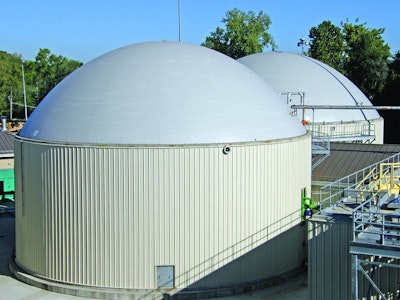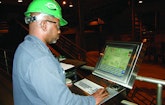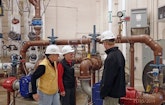
Interested in Treatment?
Get Treatment articles, news and videos right in your inbox! Sign up now.
Treatment + Get AlertsTo produce Exceptional Quality compost, staff from KB BioEnergy, a biosolids management firm, mixed sawdust with primary and waste activated sludge at the Akron (Ohio) Renewable Energy Facility.
In 2009, the sawdust price increased from $3 to $15 per cubic yard. “We used 50,000 to 60,000 cubic yards annually, but compost sales didn’t generate enough revenue to cover the increased cost,” says Annette Berger, vice president of operations. “We needed an economical alternative that dovetailed with upgrading our 25-year-old facility.”
A trip to Germany to investigate anaerobic digestion technologies introduced officials to Schmack Biogas, a member of the Viessmann Group in Schwandorf. “Their reactors were processing manure slurry at 30 percent solids while our municipal technology achieved 3 to 5 percent solids,” says Berger. “When we saw the EUCO Titan system, we wanted it.”
The two-phase, $32 million upgrade reduced annual electricity costs from $360,000 to $30,000 at the facility. The Akron facility now produces Exceptional Quality biosolids pellets, used by a landscaping company as a soil conditioner.
To the test
To test whether the technology would generate biogas from 28 percent solids material, Akron officials contracted with KB BioEnergy to build a pilot plant handling one-third of the water reclamation facility’s primary and waste activated sludge (22 to 25 million gallons per year). The successful pilot provided a baseline for the full-scale system.
Previously, Akron’s 90 mgd (design) water reclamation facility annually pumped 65 to 75 million gallons of blended, thickened sludge under the Cuyahoga River to three holding wells at the renewable energy facility. After processing, the staff managed the composting in four reactor bays. Further curing occurred outside on a concrete slab.
While composting continued, the pilot-scale plant was built. It included a 168,000-gallon EUCO 600 plug-flow digester (BIOFerm Energy), a complete mix 500,000-gallon COCCUS 2000 second-stage digester and an all-in-one container with 335 kW combined heat and power (CHP) Jenbacher engine-generator and control room (GE Energy).
The process begins with five 2-meter, 200 gpm belt presses (Andritz) dewatering 65,000 gpd of 5 percent solids material to 28 percent solids filter cake. A conveyor transports the cake to two holding bins; a screw conveyor then feeds it to the EUCO digester, maintained at 98 degrees F. Horizontal paddles on the REMEX agitator mix the solids for six to seven days, generating 50 percent of biogas production.
The solids then transfer to the COCCUS polishing reactor, also maintained at 98 degrees and equipped with the same agitator. An integrated gas-storage membrane system expands and contracts based on biogas production. Residence time is approximately 21 days. Sulfide-reducing bacteria on fixed-film media digest organic compounds, releasing biogas and carbon dioxide. “We composted the dewatered solids and used the biogas to fuel the Jenbacher engine,” says Berger.
Supercharged system
Engineers from Applied Technologies worked with their German counterparts throughout 2006, redesigning equipment to pass U.S. building codes. Meanwhile, Great Lakes Construction began the concrete work, driving pylons into soft, spongy soil to support the equipment.
Schmack shipped the components from Germany along with mechanics to install and test the equipment. A Web-based control system (Evoqua Water Technologies) allowed engineers to review and modify operations. The $7 million project took a year to complete, bringing Phase I online in November 2007.
Seed sludge obtained from another city was too thin (1 percent solids) to stabilize the bacteria, already hampered by cold weather. It took until early April to produce biogas, and production was erratic. “Schmack added bags of powdered micronutrients to manure digesters in Germany,” says Berger. “When we followed their directions, we had great gas production the first two weeks, and then it trailed off. By the fourth week, they’d tell us to add more material.”
River Bend Labs (Chemtron) tested the sludge, then injected nutrients designed specifically for the plant. “They acted like a One-A-Day vitamin on the system,” says Berger. “Biogas production became consistent, enabling the CHP engine to run smoother.” Higher efficiency generated more gas than the engine could consume. “We flared constantly. This was critical, as it helped us determine engine sizes for Phase II.”
Seasonal challenges
During the first summer, heat raised temperatures in the all-in-one container, causing the programming to derate the Jenbacher engine. An engineering firm determined where to introduce more air and how the fans should move it to cool the engine’s electronics.
That winter, the temperature in the EUCO digester dropped to 70 degrees despite heating tubes along the mixing shaft. Nevertheless, the microbes survived. The next year, engineers added a tube-in-tube heat exchanger to the unit that minimized heat loss and kept temperatures in the upper 80s during extreme cold.
KB BioEnergy used the thermal energy produced by Phase I to help heat the digesters. Any excess was released. The electric energy helped power composting operations.
Scaling up
For Phase II, BIOFerm Energy Systems/Viessmann Group, representing Schmack in the U.S., supplied two 286,000-gallon EUCO 1000 digesters and two 704,000-gallon COCCUS 3000 digesters with double-membrane domes. To maintain optimal temperatures in the tanks, engineers specified corrugated aluminum heating tubes (Brugg) around the walls. The EUCO units also had the tube-in-tube heat exchanger. “The digesters are maintaining 98 degrees in the winter now,” says Berger.
The 400 cfm of biogas they produce passes through a conditioning system (Unison Solutions) that removes hydrogen sulfide and siloxanes. KB BioEnergy sends the conditioned gas to the CHP units or the thermal-fluid heaters used by the dryer (Komline-Sanderson). The biogas also powers three 600 kW MWM engines (2G-Cenergy) to generate electricity and heat paratherm oil to 400 degrees in two thermal-fluid heaters with biogas and natural gas burners.
Two progressive cavity pumps feed 28 percent solids digested cake to the dryer, designed to process 10,000 pounds per hour. The resulting 92 to 99 percent dry pellets meet Exceptional Quality standards.
Profitable byproducts
The full-scale 143,750-square-foot plant, designed to process 197,000 gpd and produce 15,000 cubic yards annually, went online in October 2013. “Using seed sludge from Phase I enabled Phase II to produce gas in four weeks,” says Berger. “Schmack engineers were surprised since they expected startup to take four or five months.”
Phase II provided new challenges. Condensation traps on biogas lines froze in winter. Engineers added more insulation and heat tracing on the lines. Then calcium carbonate built up on the dryer’s cooling system. “As deposits accumulated, we lost our capacity to cool pellets before storage,” says Berger. “Feeding an anti-scaling chemical [Solenis] solved the problem.
The EUCO Titan technology met all the test parameters. The electricity it generates powers the renewable energy facility; if there is excess electricity, it is shared with the water reclamation facility. The thermal energy heats the digesters and provides supplemental heat to the dryer’s thermal fluid. A local landscape supplier uses the 35 to 45 cubic yards of pellets produced daily as a soil conditioner.
“Compared with composting, this process is cleaner, has a smaller footprint and is less costly to manage,” says Berger. “That is the return on our investment.”







